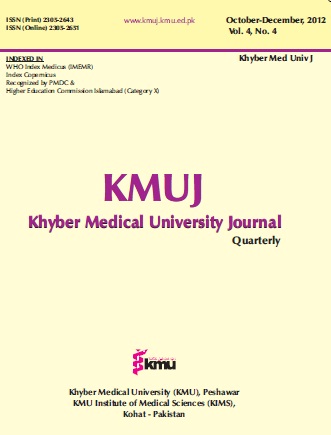PERCUTANEOUS NEPHROLITHOTOMY: A MINIMAL INVASIVE SURGICAL OPTION FOR THE TREATMENT OF STAGHORN RENAL CALCULI
Main Article Content
Abstract
Objectives: To see the safety and efficacy of percutaneous nephrolithotomy (PCNL) for the treatment of staghorn renal stone.
Methodology: This descriptive study was conducted in Department of Urology and Renal Transplantation, Institute of Kidney Diseases Hayatabad Medical Complex Peshawar, Pakistan from June 2010 to May 2012. A total of 52 patients who underwent PCNL for staghorn renal stones irrespective of the age and gender were selected for this study through the technique of non-probability consecutive sampling. All the procedures were carried out by a single surgeon, under general anesthesia and in prone position. Data was analyzed on a computer using SPSS version 10 for windows XP.
Results: Mean age was 35.9±14.5 years (range 7-59 yrs). The average procedure time was 105±19.3 minutes (range 75–180 minutes). The mean size of the stone was 3.9±1.2 cm (range 3.1-5.8 cm). In 41 of 52 (78.84%) patients, complete stone clearance was achieved after a single session of PCNL. The procedure was staged in 04 (7.7%) patients and a repeat PCNL was performed. Complete clearance (including second stage PCNL) was achieved in 44 of 52 (84.61%) patients. With dual therapy (PCNL + shock wave lithotripsy), stone clearance was achieved in 48 of 52 (92.3%) patients. The commonest complication encountered was bleeding in 4/52 (7.7%) patients necessitating blood transfusion. The mean hospital stay was 3±0.9 days and nephrostomy tube was kept for 2 days.
Conclusion: PCNL is safe and effective treatment for staghorn renal calculi associated with less morbidity and shorter hospital stay.
Key Words: Staghorn stone, Percutaneous Nephrolithotomy (PCNL), Efficacy.
This article may be cited as: Ullah A, Khan MK, Rahman AU, Rehman RU. Percutaneous nephrolithotomy: A minimal invasive surgical option for the treatment of staghorn renal calculi. Khyber Med Univ J 2012; 4(4): 156-160.
Article Details
Work published in KMUJ is licensed under a
Creative Commons Attribution 4.0 License
Authors are permitted and encouraged to post their work online (e.g., in institutional repositories or on their website) prior to and during the submission process, as it can lead to productive exchanges, as well as earlier and greater citation of published work.
(e.g., in institutional repositories or on their website) prior to and during the submission process, as it can lead to productive exchanges, as well as earlier and greater citation of published work.
References
Husain M, Rizvi SAH, Askari H, Sultan G, Lal M. Management
of stone diseases: 17 years experience of stone clinic in a developing country. J Pak Med Assoc 2009;29(12):843-6.
Saussine C, Lechevallier E, Traxer O. Staghorn or
complex calculi: medical considerations. Prog Urol
;18(12):963-5.
Kuzgunbay B, Turunc T, Yaycioglu O, Kayis AA, Gul U,
Egilmez T, et al. Percutaneous nephrolithotomy for staghorn
kidney stones in elderly patients. J Urol Nephrol.
;43(3):639-43.
Blandy JP, Singh M. The case for a more aggressive
approach to staghorn stones. J Urol 1976;115:505–6.
Resorlu B, Kara C, Oguz U, Bayindir M, Unsal A. Percutaneous nephrolithotomy for complex caliceal and
staghorn stones in patients with solitary kidney. Urol
Res. 2011;39(3):171-6.
Lahme S, Bichler KH, Strohmaier WL, Gotz T. Minimally
invasive PCNL in patients with renal pelvic and calyceal
stones. Eur Urol 2001;40:619-24.
Al-Kohlany KM, Shokeir AA, Mosbah A, Mohsin T, Shoma
AM, Eraki I et al. Treatment of complete staghorn
stones: A prospective randomized comparison of open
surgery versus percutaneous nephrolithotomy. J Urol
;173(2):469-73.
Preminger GM, Assimos DG, Lingeman JE, Nakada SY,
Pearle MS, Wolfe JS. AUA Nephrolithiasis Guideline Panel.
Chapter 1: AUA guideline on management of staghorn
calculi: Diagnosis and treatment recommendations. J
Urol 2005;173:1991–2000.
Saucy F, Duvdevani M, Nott L, Denstedt JD, Helmbold
P, Caniatti M et al. Percutaneous Nephrolithotomy for
Staghorn Calculi: A Single Center’s Experience over 15
Years. J Endourology 2009;23(10): 1669-73.
Netto RN, Claro JF, Ferreira U: Is percutaneous monotherapy for staghorn calculous still indicated in the era
of extracorporeal shock wave lithotripsy? J Endourol
,8:195-197.
Razvi H, Denstedt JD, Sosa RE, Vaughan ED Jr: Endoscopic lithotripsy devices. AUA update series 1995,
(lesson 14):290-6.
Lingeman JE, Lifshitz DA, Evan AP: Surgical management
of urinary lithiasis. In Campbell’s Urology Edited
by: Walsh PC, Retik AB,Vaughan EDJ. W. B. Saunders
company: Philadelphia; 2002:3361-3451.
Ziaee SA, Sichani MM, Kashi AH, Samzadeh M. Evaluation
of the learning curve for percutaneous nephrolithotomy.
Urol J 2010;7(4):226-31.
Singla M, Srivastava A, Kapoor R, Gupta N, Ansari MS,
Dubey D, Kumar A: Aggressive approach to staghorn
calculi-safety and efficacy of multiple tracts percutaneous
nephrolithotomy. Urology 2008, 71(6):1039-42.
Holman E, Khan AM, Pasztor I, Toth C: Simultaneous
bilateral compared with unilateral percutaneous nephrolithotomy. BJU Int 2002, 89(4):334-8.
Jou YC, Cheng MC, Lin CT, Chen PC, Shen JH: Nephrostomy tube-free percutaneous nephrolithotomy for
patients with large stones and staghorn stones. Urology
, 67(1):30-4.
El-Nahas AR, Eraky I, Shokeir AA, Shoma AM, el-Assmy
AM, el-Tabey NA et al. Factors affecting stone-free rate
and complications of percutaneous nephrolithotomy for
treatment of staghorn stone. J Urology 2012;79(6):1236-
Manohar T, Ganpule AP, Shrivastav P, Desai M. Percutaneous nephrolithotomy for complex caliceal calculi and
staghorn stones in children less than 5 years of age. J
Endourol 2006;20(8):547-51.
Davol PE, Wood C, Fulmer B. Success in treating renal calculi with single-access, single-event percutaneous
nephrolithotomy: is a routine “second look” necessary?
J Endourol 2006;20(5):289-92.
Gleeson MJ, Griffith DP: Extracorporeal shock wave
lithotripsy monotherapy for large renal calculi. Br J Urol
;64:329.
Kurtulus F, Fazlioglu A, Tandogdu Z, Karaca S, Salman
Y, Cek M. Analysis of factors related with bleeding in
percutaneous nephrolithotomy using balloon dilatation.
Canadian J Urol 2010;17(6):5483-9.
